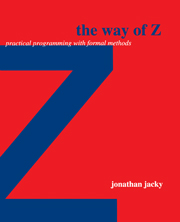Book contents
- Frontmatter
- Contents
- Preface
- I Why Z?
- II Introducing Z
- III Elements of Z
- IV Studies in Z
- 16 Document control system
- 17 Text processing
- 18 Eight queens
- 19 Computer graphics and computational geometry
- 20 Rule-based programming
- 21 Graphical user interface
- 22 Safety-critical protection system
- 23 Modelling large systems
- 24 Object-oriented programming
- 25 Concurrency and real time
- Further reading
- V Programming with Z
- Further reading
- A Glossary of Z notation
- B Omitted features
- C Operator precedence
- D The Z mathematical tool-kit
- E Selected Laws
- F Solutions to selected exercises
- G Other formal notations
- Bibliography
- Index
20 - Rule-based programming
Published online by Cambridge University Press: 06 July 2010
- Frontmatter
- Contents
- Preface
- I Why Z?
- II Introducing Z
- III Elements of Z
- IV Studies in Z
- 16 Document control system
- 17 Text processing
- 18 Eight queens
- 19 Computer graphics and computational geometry
- 20 Rule-based programming
- 21 Graphical user interface
- 22 Safety-critical protection system
- 23 Modelling large systems
- 24 Object-oriented programming
- 25 Concurrency and real time
- Further reading
- V Programming with Z
- Further reading
- A Glossary of Z notation
- B Omitted features
- C Operator precedence
- D The Z mathematical tool-kit
- E Selected Laws
- F Solutions to selected exercises
- G Other formal notations
- Bibliography
- Index
Summary
Some problems present us with a large collection of facts and rules, but no underlying theory that we can use to design a compact algorithm for calculating a solution. Examples of such problems include medical diagnosis and treatment planning, scheduling jobs in a machine shop, diagnosis and repair of malfunctioning machinery, and determining customers' eligibility for financial credit. In these areas there are no simple first principles from which everything follows; instead, there are a lot of empirical observations and rules gleaned from hard experience or laid down by fiat. Sometimes you can find an acceptable solution by searching for relevant facts and applying the pertinent rules. Rule-based programming mechanizes this style of problem solving.
Rule-based programs are sometimes called expert systems and are said to display artificial intelligence, but they are just computer programs that employ some specialized techniques that have been found useful for certain kinds of problems. If such a program is intended for a serious purpose, it must meet the same standards of quality and correctness required of other programs. How can we tell if a rule-based program has computed the right answer?
Rule-based programs are often evaluated by submitting some sample results to a panel of human experts. This kind of validation can be helpful but it does not provide sufficient coverage to detect every incorrect result nor does it provide any guidance for design and implementation.
- Type
- Chapter
- Information
- The Way of ZPractical Programming with Formal Methods, pp. 189 - 198Publisher: Cambridge University PressPrint publication year: 1996

